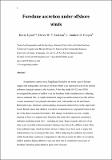Foredune accretion under offshore winds

View/
Date
2007Author
Cooper, J. Andrew G.
Jackson, Derek W. T.
Lynch, Kevin
Metadata
Show full item recordUsage
This item's downloads: 1226 (view details)
Recommended Citation
Lynch, K., Jackson, D.W.T. and Cooper, J.A.G., 2009. Foredune accretion under offshore winds. Geomorphology, 105(1-2): 139-146.
Published Version
Abstract
Experiments carried out at Magilligan Strand on the north coast of Ireland
suggest that topographic steering of offshore winds is an important facet of the aeolian
sediment transport system at this location. A five-day study (18-22 June 2005)
investigated the pattern of airflow over the foredune while simultaneously collecting
data on sediment flux. A simple instrument setup was used to characterise the airflow:
a sonic anemometer was placed at the dune crest, with another on the mid-beach.
Horizontal traps, electronic and integrating, measured sediment flux on the supra-tidal
beach. Results show that offshore wind flow deviated from its original direction in the
lee of the dune (seaward of foredune). The change in direction was not a simple
steering of flow to a singular new direction, but rather flow separation resulting in
turbulent multidirectional flow ¿ including reversal. Traps located at the foot of the
dune scarp recorded sediment transport during events forced by offshore winds. Data
from sediment traps, wind and observational evidence have been used to argue that
sedimentation was occurring in this zone. When budgeting for sediment movement
within beach-dune systems it is important to take into account the effect of secondary
airflow patterns during offshore winds and their role in constructive processes of
foredune formation, particularly in post-storm recovery.

